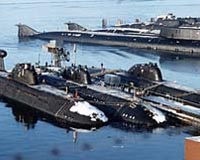
Living Among Dead Submarines
Moscow Jul 14, 2008: Ten years ago Russia started to dismantle nuclear-powered submarines withdrawn from combat duty. This hard and dangerous work is still going on, but the end is in sight.
For Russia, maintaining a huge navy turned out to be wasteful and pointless, and so the decision was taken to reduce the number of combat units in the Far Eastern and north-western parts of Russia.
Today some 200 Russian nuclear submarines and three nuclear-powered surface ships already pose no threat to any opponent.
Yevgeny Kudryavtsev, director of the fuel cycle, waste and decommissioning department at Rosatom (Russian Nuclear Power Agency), says the task of dismantling the surface ships and submarines withdrawn from service is almost accomplished. By 2010 almost all the decommissioned vessels will be dismantled.
"Dismantlement" here does not imply complete dismantlement. The submarines have not disappeared. Like dead fish, most parts of the once formidable vessels remain ashore or at anchor. Experts say the total activity of the nuclear waste still aboard the vessels and at naval bases exceeds 25 million Ci. The total weight of contaminated structures subject to dismantlement exceeds 150,000 tons.
The reason is that the Russian nuclear industry was simply unprepared to "digest" nuclear waste in such large quantities. An average of 14-16 submarines were withdrawn from service every year, with only three or four of them being dismantled.
This soon resulted in the volume of nuclear fuel, unloaded from the submarines and piled up at four coastal engineering facilities, expanding beyond the storage capacity.
The infrastructure did not meet security standards, and the risk of accident remained high, with dozens of tons of nuclear fuel and tens of thousands cubic meters of liquid and solid nuclear waste stored at the facilities. The potential radioactivity of the materials stored there exceeded the fallout from the Chernobyl disaster.
Before 1998 the Defense Ministry was responsible for dismantling naval vessels. Later nuclear engineers were involved, developing special security measures that eventually changed the situation. "Dry" temporary storage was introduced, metal-and-concrete containers were developed, storage areas expanded, and additional trains and special wagons put into operation.
Russia alone was not capable of carrying out the whole dismantlement program, and the international community willingly offered money to neutralize the armada of decommissioned Russian submarines. According to the G8 Global Partnership Against the Spread of Weapons and Materials of Mass Destruction program (Kananaskis, Canada), $20 billion were earmarked for dismantlement of nuclear-powered vessels in 2002-2012.
Russia's main partners in the dismantlement process are Great Britain, Germany, Norway, Sweden and France. The program was supported by the Northern Dimension fund, the TACIS program (EU program for technical assistance) and the IAEA. Today Russia has agreements with the U.S., Canada, Italy and Japan.
Rosatom reports that in the past six years foreign partners have financed the complete dismantlement of 26 submarines, and 14 more vessels are in the line. The bulk of the costs, however, are borne by Russia, which is financing the dismantlement of 70 vessels.
The mass of metal that was once Russia's nuclear navy totals 1.5 million tons. The special trains will have to run at least 100 journeys to transfer that daunting mass from Russia's north-west to the Mayak chemicals plant near Chelyabinsk in the Urals, which holds the monopoly on recycling nuclear waste.
However, the trains are capable of running only 10-15 journeys a year. This means no rapid evacuation is possible, and the remnants of nuclear submarines will remain on Russia's shores for a long time to come.
Theoretically, dismantlement is considered complete after all the nuclear materials and equipment of a submarine are recycled.
However, due to a high level of residual radiation, a submarine's reactor plant takes 50-70 years before it can safely be dismantled, unless young physicists invent something new in the meantime. Reactor compartments are therefore extracted from submarine hulls, isolated and put into storage areas. Yet there is a shortage of storage space and some of these compartments are kept afloat.
These "floating coffins" worry Russia's European neighbors most, though the situation is improving. With Germany's financial assistance, a long-term storage facility for reactor compartments from all over the north-western part of Russia is being built at the Sayda Bay on the Kola Peninsula.
Experts urge people not to yield to radiophobia, as fears of environmental disaster at the dismantlement site are almost baseless.
Experts at the All-Russian Scientific Research and Development Institute of Energy Technology in St. Petersburg say that even in a worst-case scenario the expected radiation level will not exceed the current sanitary standards.
A gas-aerosol fallout is also possible, but its effect would be insignificant and would pose no threat to the population. The density of fallout on the ground would be low, and no disposal of contaminated water is done at the storage facility. Security of the facility is guaranteed by innovative technologies and well-qualified personnel.


















No comments:
Post a Comment